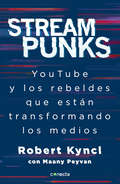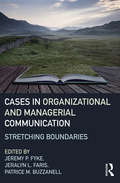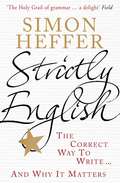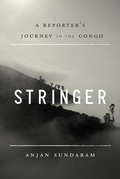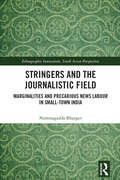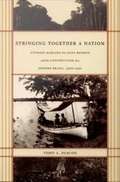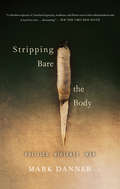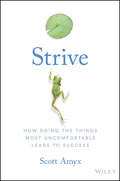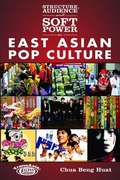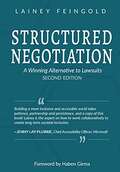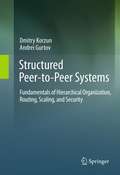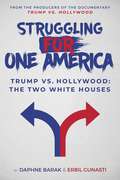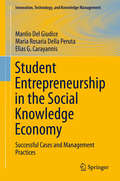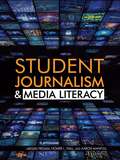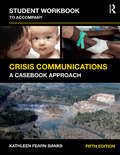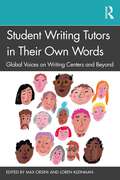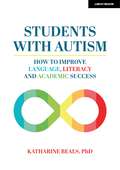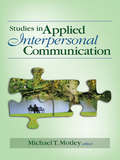- Table View
- List View
Streampunks: Youtube y los rebeldes que estan transformando los medios
by Robert Kyncl<P>En los últimos diez años, la plataforma de videos por internet YouTube ha cambiado los medios y el entretenimiento tan profundamente como lo hicieron la invención del cine, la radio y la televisión. <P>Streampunks es una mirada a esta empresa advenediza que examina cómo ha evolucionado YouTube y hacia dónde va. <P>Basándose en relatos de las estrellas más influyentes de YouTube (Streampunks como Tyler Oakley, Lilly Singh y Casey Neistat) y los negociadores que promueven el futuro del entretenimiento (como Scooter Braun y Shane Smith), Robert Kyncl utiliza sus experiencias en tres de las compañías de medios más innovadoras, HBO, Netflix y Youtube, para contar la historia del streaming y de este monstruo moderno de la cultura pop. <P>En colaboración con Maany Peyvan (escritor de contenido de Google), Kyncl explica cómo se dictan las nuevas reglas del entretenimiento y cómo y por qué el panorama de los medios está cambiando radicalmente.
Street Photography
by Gordon LewisSince the advent of the camera, there have been photographers whose mission is to record and interpret the public sphere in all its aspects. Eugene Atget documented evidence of everyday life in the streets as well as the buildings and monuments of Paris. Henri Cartier-Bresson pursued what he called "The Decisive Moment," the moment in which the meaning of an event was most clearly captured in a photograph. Their work, and that of many other masters, has inspired generations of photographers to wander public spaces, camera in hand, searching for meaningful moments in time.Success requires the street photographer to be proficient with their equipment, to be constantly aware of their surroundings, and to have a keen eye. Quick reflexes and self-confidence are essential: Street photographers know from experience that hesitation or procrastination could mean missing a once-in-a-lifetime shot. The adage "it's better to ask for forgiveness than permission" was probably coined by a street photographer. In Street Photography: The Art of Capturing the Candid Moment, Gordon Lewis helps readers understand and conquer the challenging yet rewarding world of street photography. The book includes discussions of why photographers are drawn to street photography, the different styles of street photography, and what makes a great street photograph. Lewis then goes on to explore how the choice of location can change a photographer's approach to image capture: from city streets to fairs to beaches, Lewis discusses the impact different environments have on the process of street photography. Another crucial element to becoming a good street photographer is learning to travel light, with minimal equipment. Lewis gives readers practical advice on everything from cameras and lenses to camera bags and clothing. Lewis also delves into the techniques and approaches that will help novices master the art of street photography. Whether your style is to engage your subjects or to remain unnoticed and take candid portraits, Lewis offers ideas on how to capture fascinating moments in time: a gesture, expression, or composition that may exist for only a fraction of a second, but can leave a lasting impression of the wonders, challenges, and absurdities of modern life.
Stretching Boundaries: Stretching Boundaries
by Patrice M. Buzzanell Jeremy Fyke Jeralyn FarisStretching Boundaries: Cases in Organizational and Managerial Communication focuses on non-traditional organizations in a variety of contexts. Because cases range from small family-owned entrepreneurships and cybervetting to provincial egovernment democratic movements in China, this supplemental text enables a reexamination of the boundaries of traditional organizational contexts. Cases delve into organizing structures, relationships, and visions for global not-for-profits, hybrid, creative industry, and entrepreneurial organizations. This book stands to benefit instructors and students in at least four ways. First, it provides instructors with an application-based teaching tool to help spark discussion. Second, students will find the case studies interesting and applicable to their future work lives, especially undergraduates who will soon be in the work force. Additionally, cases help students grasp course materials that may be otherwise challenging. Finally, for graduate students, the book encourages reflection on important topics for future research.
Strictly English: The correct way to write ... and why it matters
by Simon Heffer"Be in no doubt: the beer was drunk but the man drank the beer.""We must avoid vulgarities like 'front up'. If someone is 'fronting up' a television show, then he is presenting it."Simon Heffer's incisive and amusingly despairing emails to colleagues at the The Daily Telegraph about grammatical mistakes and stylistic slips have attracted a growing band of ardent fans over recent years. Now, in his new book Strictly English, he makes an impassioned case for an end to the sloppiness that has become such a hallmark of everyday speech and writing, and shows how accuracy and clarity are within the grasp of anyone who is prepared to take the time to master a few simple rules.If you wince when you see "different than" in print, or are offended by people who think that "infer" and "imply" mean the same thing, then this book will provide reassurance that you are not alone. And if you believe that precise and elegant English really does matter, then it will prove required reading.
Stringer
by Anjan SundaramIn the powerful travel-writing tradition of Ryszard Kapuscinski and V.S. Naipaul, a haunting memoir of a dangerous and disorienting year of self-discovery in one of the world's unhappiest countries.
Stringers and the Journalistic Field: Marginalities and Precarious News Labour in Small-Town India (Ethnographic Innovations, South Asian Perspectives)
by Nimmagadda BhargavThis book is one of the first ethnographic works on small-town stringers or informal news workers in Indian journalism. It explores existing practices and cultures in the field of local journalism and the roles and spaces stringers occupy. The book outlines the caste, gender, class and region-based biases in the production of Indian-language journalism with a specific focus on stringers working in Telugu dailies in small towns or ‘mofussil’ areas of Andhra Pradesh and Telangana, states in south India. Further, it captures their daily work and processes of news production, and the precarious lives they often lead while working in small towns or mofussils. The author, by using Bourdieu’s field theory, introduces the journalistic practices of stringers working on the margins and how they negotiate the complex hierarchies that exist within the journalistic field and outside it. This book will be of great interest to scholars and researchers of ethnography, media sociology, journalism and media studies, labour studies and Area studies, especially South Asian studies.
Stringing Together a Nation: Cândido Mariano Da Silva Rondon and the Construction of a Modern Brazil, 1906-1930
by Todd A. DiaconFocusing on one of the most fascinating and debated figures in the history of modern Brazil, Stringing Together a Nation is the first full-length study of the life and career of Cndido Mariano da Silva Rondon (1865-1958) to be published in English. In the early twentieth century, Rondon, a military engineer, led what became known as the Rondon Commission in a massive undertaking: the building of telegraph lines and roads connecting Brazil's vast interior with its coast. Todd A. Diacon describes how, in stringing together a nation with telegraph wire, Rondon attempted to create a unified community of "Brazilians" from a population whose loyalties and identities were much more local and regional in scope. He reveals the work of the Rondon Commission as a crucial exemplar of the issues and intricacies involved in the expansion of central state authority in Brazil and in the construction of a particular kind of Brazilian nation. Using an impressive array of archival and documentary sources, Diacon chronicles the Rondon Commission's arduous construction of telegraph lines across more than eight hundred miles of the Amazon Basin; its exploration, surveying, and mapping of vast areas of northwest Brazil; and its implementation of policies governing relations between the Brazilian state and indigenous groups. He considers the importance of Positivist philosophy to Rondon's thought, and he highlights the Rondon Commission's significant public relations work on behalf of nation-building efforts. He reflects on the discussions--both contemporaneous and historiographical--that have made Rondon such a fundamental and controversial figure in Brazilian cultural history.
Stripped: Reading the Erotic Body (RSA Series in Transdisciplinary Rhetoric #14)
by Maggie M. WernerStripped examines the ways in which erotic bodies communicate in performance and as cultural figures. Focusing on symbols independent of language, Maggie M. Werner explores the signs and signals of erotic dance, audience responses to these codes, and how this exchange creates embodied rhetoric.Informed by her own ethnographic research conducted in strip clubs and theaters, Werner analyzes the movement, dress, and cosmetic choices of topless dancers and neo-burlesque performers. Drawing on critical methods of analysis, she develops approaches for interpreting embodied erotic rhetoric and the marginal cultural practices that construct women’s public erotic bodies. She follows these bodies out into the streets—into the protest spaces where sex workers and anti-rape activists challenge discourses about morality and victimhood and struggle to remake their own identities. Throughout, Werner showcases the voices of these performers and in the analyses shares her experiences as an audience member, interviewer, and paying customer. The result is a uniquely personal and erudite study that advances conversations about women’s agency and erotic performance, moving beyond the binary that views the erotic body as either oppressed or empowered.Theoretically sophisticated and delightfully intimate, Stripped is an important contribution to the study of the rhetoric of the body and to rhetorical and performance studies more broadly.
Stripped: Reading the Erotic Body (RSA Series in Transdisciplinary Rhetoric)
by Maggie M. WernerStripped examines the ways in which erotic bodies communicate in performance and as cultural figures. Focusing on symbols independent of language, Maggie M. Werner explores the signs and signals of erotic dance, audience responses to these codes, and how this exchange creates embodied rhetoric.Informed by her own ethnographic research conducted in strip clubs and theaters, Werner analyzes the movement, dress, and cosmetic choices of topless dancers and neo-burlesque performers. Drawing on critical methods of analysis, she develops approaches for interpreting embodied erotic rhetoric and the marginal cultural practices that construct women’s public erotic bodies. She follows these bodies out into the streets—into the protest spaces where sex workers and anti-rape activists challenge discourses about morality and victimhood and struggle to remake their own identities. Throughout, Werner showcases the voices of these performers and in the analyses shares her experiences as an audience member, interviewer, and paying customer. The result is a uniquely personal and erudite study that advances conversations about women’s agency and erotic performance, moving beyond the binary that views the erotic body as either oppressed or empowered.Theoretically sophisticated and delightfully intimate, Stripped is an important contribution to the study of the rhetoric of the body and to rhetorical and performance studies more broadly.
Stripping Bare the Body: Politics Violence War
by Mark DannerFor the past two decades, Mark Danner has reported from Latin America, Haiti, the Balkans, and the Middle East. His perceptive, award-winning dispatches have not only explored the real consequences of American engagement with the world, but also the relationship between political violence and power. In Stripping Bare the Body, Danner brings together his best reporting from the world’s most troubled regions-from the fall of the Duvalier dictatorship in Haiti to the tumultuous rise of Aristide; from the onset of the Balkan Wars to the painful fragmentation of Yugoslavia; and finally to the disastrous invasion of Iraq and the radical, destructive legacy of the Bush administration. At a time when American imperial power is in decline, there has never been a more compelling moment to read these urgent, fiercely intelligent reports.
Strive: How Doing The Things Most Uncomfortable Leads to Success
by Scott AmyxHas success eluded you, no matter how hard you try? Are you frustrated by trying to achieve your dreams by copying others? Internationally-acclaimed speaker and founder of the cutting-edge venture capital Amyx Ventures, Scott Amyx reveals how you can attain real success in your life, your way. His theory of Strive is a challenge to the conventional wisdom that has held so many people back from achieving their goals and enjoying lasting happiness. Scott rose from obscure poverty to globe-trotting success, and he invites you to share in his journey by adopting a new mindset towards your personal challenges: embrace them. Scott shows you how through stories of the most unlikely individuals who embraced difficult personal change to become outrageously successful. He helps you take stock of your own habits and practices to identify how your routine and misconceptions are holding you back. Fascinating insights from throughout history up through today’s cutting-edge research show how embracing discomfort fuels lasting success. Shape your life in new, exciting ways. You can have control over your career, your outlook, your actions, and your priorities. This book helps you get a fresh start to begin building the successful life you want. Discover what really drives success---and how conventional wisdom is wrong Clearly identify your own personal challenges---and how to overcome them Delve into the latest research on high performance to create a better you Learn how high-achievers approach challenge, change, and success Strive is an unconventional approach to attaining your dreams because it takes what makes you unique and turns it to your advantage. Have you been duped by common myths of success? Are you disappointed by the constant struggle in life? Scott reveals how only you have the power to change your trajectory. Strive is your handbook for getting comfortable with discomfort, embracing and enjoying new challenges, and achieving real, lasting success.
Structural Analysis in the Social Sciences: Mobilizing Poor Voters
by Mariela SzwarcbergDemocracy has provided opportunities for political representation and accountability, but it has also created incentives for creating and maintaining clientelistic networks. Why has clientelism consolidated with the introduction of democracy? Drawing on network analysis, Mobilizing Poor Voters answers this question by describing and explaining the emergence, maintenance, and disappearance of political, partisan, and social networks in Argentina. Combining qualitative and quantitative data gathered during twenty-four months of field research in eight municipalities in Argentina, Mobilizing Poor Voters shows that when party leaders distribute political promotions to party candidates based only on the number of voters they mobilize, party leaders incentivize the use of clientelistic strategies among candidates competing to mobilize voters in poor neighborhoods. The logic of perverse incentives examined in this book explains why candidates who use clientelism succeed in getting elected and re-elected over time, contributing to the consolidation of political machines at the local level.
Structure, Audience and Soft Power in East Asian Pop Culture
by Chua Beng HuatEast Asian pop culture can be seen as an integrated cultural economy emerging from the rise of Japanese and Korean pop culture as an influential force in the distribution and reception networks of Chinese language pop culture embedded in the ethnic Chinese diaspora. Taking Singapore as a locus of pan-Asian Chineseness, Chua Beng Huat provides detailed analysis of the fragmented reception process of transcultural audiences and the processes of audiences' formation and exercise of consumer power and engagement with national politics. In an era where exercise of military power is increasingly restrained, pop culture has become an important component of soft power diplomacy and transcultural collaborations in a region that is still haunted by colonization and violence. The author notes that the aspirations behind national governments' efforts to use popular culture is limited by the fragmented nature of audiences who respond differently to the same products; by the danger of backlash from other members of the importing country's population that do not consume the popular culture products in question; and by the efforts of the primary consuming country, the People's Republic of China to shape products through co-production strategies and other indirect modes of intervention.
Structured Negotiation: A Winning Alternative to lawsuits
by Lainey FeingoldLainey is the expert on how to work collaboratively to create long term societal inclusion.” — Jenny Lay-Flurrie, Chief Accessibility Officer, Microsoft “This fantastic guide to structured negotiations provides valuable insights for anyone interested in becoming a better advocate. I really enjoyed reading this book and appreciate all the lessons within.” — Haben Girma, Human rights lawyer and author of the best seller, Haben, the Deafblind Woman Who Conquered Harvard Law. ——— Structured Negotiation: A Winning Alternative to Lawsuits shares stories and strategies from 25 years of successful collaborations between the disability community and some of the largest public and private organizations in the United States. Born at the intersection of accessibility, technology, disability, and dispute resolution, the pioneering strategy described in this book has been instrumental in creating a more inclusive digital world for a quarter century. First published by the American Bar Association, the Second Edition includes new Structured Negotiation win-wins, other new content, and Forewords by Haben Girma, author of the best-selling Haben: The Deafblind Woman Who Conquered Harvard Law and by Susana Sucunza, Basque Country Spain collaborative lawyer and president of the Basque Country Collaborative Law Association. Not just for lawyers, the book offers an effective and path-breaking method to resolve disputes without lawsuits, and to lessen the conflict and expense of filed cases. Lawsuits play an important role in moving society forward. But the legal profession ― and the public it serves ― deserve less costly, less stressful, and more cooperative and ethical alternatives. Clients need a forum where stories matter. Would-be defendants need a process that allows them to do the right thing without having to prove there is no problem to begin with.
Structured Peer-to-Peer Systems
by Dmitry Korzun Andrei GurtovThe field of structured P2P systems has seen fast growth upon the introduction of Distributed Hash Tables (DHTs) in the early 2000s. The first proposals, including Chord, Pastry, Tapestry, were gradually improved to cope with scalability, locality and security issues. By utilizing the processing and bandwidth resources of end users, the P2P approach enables high performance of data distribution which is hard to achieve with traditional client-server architectures. The P2P computing community is also being actively utilized for software updates to the Internet, P2PSIP VoIP, video-on-demand, and distributed backups. The recent introduction of the identifier-locator split proposal for future Internet architectures poses another important application for DHTs, namely mapping between host permanent identity and changing IP address. The growing complexity and scale of modern P2P systems requires the introduction of hierarchy and intelligence in routing of requests. Structured Peer-to-Peer Systems covers fundamental issues in organization, optimization, and tradeoffs of present large-scale structured P2P systems, as well as, provides principles, analytical models, and simulation methods applicable in designing future systems. Part I presents the state-of-the-art of structured P2P systems, popular DHT topologies and protocols, and the design challenges for efficient P2P network topology organization, routing, scalability, and security. Part II shows that local strategies with limited knowledge per peer provide the highest scalability level subject to reasonable performance and security constraints. Although the strategies are local, their efficiency is due to elements of hierarchical organization, which appear in many DHT designs that traditionally are considered as flat ones. Part III describes methods to gradually enhance the local view limit when a peer is capable to operate with larger knowledge, still partial, about the entire system. These methods were formed in the evolution of hierarchical organization from flat DHT networks to hierarchical DHT architectures, look-ahead routing, and topology-aware ranking. Part IV highlights some known P2P-based experimental systems and commercial applications in the modern Internet. The discussion clarifies the importance of P2P technology for building present and future Internet systems.
Struggling for One America: Trump vs. Hollywood: The Two White Houses
by Daphne Barak Erbil GunastiWhat happens when you speak with Hollywood stars and entertainers—half pro-Trump and half against—posting the question, &“Can we talk?&” Since the 2016 presidential campaigns, Conservatives, Liberals, Democrats, Republicans, Whites, and non-Whites in America began saying loudly that they are &“Fighting for America.&” Yet, by the 2020 presidential elections, they were even more divided than united despite all the good intention of the most. Now that America is well into 2021, it is time to yearn for &“One America&” but without &“fighting.&” But here is the caveat! To achieve &“One America,&” the &“Trump Phenomena&” must first be understood. Next, &“Discrimination&” and &“Racism&” in America must be re-visited. After that, &“Cancel Culture&” and &“No-No Rhetoric&” must be handled promptly and sensitively. Finally, Hollywood must first embrace #MeToo Movement and then come up with a long-term strategy. Filmmakers of the Trump vs. Hollywood documentary, Daphne Barak and Erbil Gunasti brought on board twenty-four Hollywood stars and entertainers in a documentary to discuss these topics. Half were chosen among pro-Trump, and half against. Daphne interviewed both sides, posing the question: &“Can We Talk?&”Struggling For One America stands as the genesis of this documentary. This book in that respect points at the presumptive and pretended &“Culprits&” and &“Scapegoats&” in the current divide, while focusing on what is obvious. The two White Houses are standing tall, in plain sight, and a step further on the wrong direction from this moment on would be nothing less than repeating history.
Student Entrepreneurship in the Social Knowledge Economy
by Maria Rosaria Della Peruta Manlio Del Giudice Elias G. CarayannisTraditionally, the study of entrepreneurial behavior focuses on such factors as (i) the personality characteristics that distinguish the entrepreneur from non-entrepreneur and (ii) demographic characteristics such gender, age, familiar antecedents and education. With particular respect to investigating the development, acquisition, and dissemination of entrepreneurial skills and behaviors, the authors focus on the university environment, as a locus of research and innovation, where students are exposed to a wide variety of influences that are enhanced by a high degree of connectivity. The underlying theme of this volume is to develop our understanding of the sociology of student entrepreneurial behavior and in doing so attempt to synthesize literature investigating individual talent with the literature on concurrent knowledge sourcing in the pursuit of entrepreneurial activities. Specifically, the authors investigate the degree to which access to diverse knowledge (in addition to such psychological characteristics and tolerance of ambiguity and risk taking) influences the nature and probability of entrepreneurial success. Moreover, they explore the role of social media and social networking in facilitating access to distributed and disparate information and knowledge Their research addresses such timely questions as: Where do entrepreneurial opportunities come from? How can higher education best stimulate the creation of firms emanating from young and smart minds in colleges and universities? What is the value of MOOCs for frequent, early, and "thick" communication among the various specialties needed to accomplish entrepreneurial projects? How do we know whether social media affect students' responses to new knowledge and new ideas? To what extent do educational practices affect racial and ethnic differences in student entrepreneurship? What is the role of the indigenous minority student entrepreneur in establishing high-technology firms? The result is a multi-dimensional approach that sheds light on the dynamics of education, knowledge creation, social networking, innovation and new business development.
Student Journalism and Media Literacy
by Homer L. Hall Aaron Manfull Megan FrommThis comprehensive resource covers everything student journalists need to know in a rapidly changing media landscape. Approachable and non-intimidating, this book features important concepts and examples from current school publications from around the country. Foremost, it teaches skills such as the fundamentals of good writing and the basics of newspaper layout and design. Also addressed, however, are topics that journalists are only now facing such as the responsibilities of citizen journalists, managing a news website, and digital security for reporters in the electronic age. This textbook is on the cutting edge in teaching students how to navigate this evolving field.
Student Study Guide for use with Traditions and Encounters, A Global Perspective on the Past, Volume 1, From the Beginning to 1500
by Jerry H. Bentley Herbert F. Ziegler Rose Mary SheldonNIMAC-sourced textbook
Student Workbook to Accompany Crisis Communications: A Casebook Approach
by Kathleen Fearn-Banks Kathleen Fearn_BanksNo company, organization, or individual whose livelihood depends on public reaction can afford to function without a crisis communications plan. This student workbook reviews the critical terminologies, processes, and skills needed for understanding and responding to crises. It prepares individuals for responding to crises in a variety of contexts, and reinforces strategies and tactics to be used during a crisis. Chapters include instructive case studies of public relations professionals in crises: what they did, what they wished they had done, and what hampered their progress. The exercises provide students with the opportunity to respond to real-world crises, sharpening their own skills and practicing response behaviors. This workbook will serve as a useful tool for all future practitioners.
Student Writing Tutors in Their Own Words: Global Voices on Writing Centers and Beyond
by Max OrsiniStudent Writing Tutors in Their Own Words collects personal narratives from writing tutors around the world, providing tutors, faculty, and writing center professionals with a diverse and experience-based understanding of the writing support process.Filling a major gap in the research on writing center theory, first-year writing pedagogy, and higher education academic support resources, this book provides narrative evidence of students' own experiences with learning assistance discourse communities. It features a variety of voices that address how academic support resources such as writing centers have served as the nucleus for students' (i.e., both tutors and their clients) sense of community and self, ultimately providing a space for freedom of discourse and expression. It includes narratives from writing tutors supporting students in unconventional spaces such as prisons, tutors offering support in war-torn countries, and students in international centers facing challenges of distance learning, access, and language barriers. The essays in this collection reveal pedagogical takeaways and insights about both student and tutor collaborative experiences in writing center spaces.These essays are a valuable resource for student writing tutors and anyone involved with them, including composition instructors and scholars, writing center professionals, and any faculty or administrators involved with academic support programs.
Students with Autism: How to improve language, literacy and academic success
by Katharine BealsBeals describes the root causes of the language and learning challenges in autism, their various academic consequences, and a variety of tools and strategies for addressing them. Drawing on what the most current evidence shows about the nature of autism and which therapies are most successful, the book discusses the implications for autism-friendly instruction in academic subjects, noting the ways in which today's classrooms come up short, and suggesting various adjustments that teachers can make.Instead of focusing on social and behavioral issues, general accommodations, and general ways to address learning difficulties, Beals zeros in on academics, on accommodations within specific academic subjects, and on techniques that target autism-specific deficits, situating the issue of educational access within the broader context of disability rights, neurodiversity, and debates about what disability rights and neurodiversity should encompass.Complete acceptance of individuals on the autism spectrum must include complete educational access. This means rethinking assumptions about autistic students, about how we teach expressive language, about how we teach reading comprehension, and about what and how we teach in the many K-12 classrooms attended by autistic students.
Students with Autism: How to improve language, literacy and academic success
by Katharine BealsBeals describes the root causes of the language and learning challenges in autism, their various academic consequences, and a variety of tools and strategies for addressing them. Drawing on what the most current evidence shows about the nature of autism and which therapies are most successful, the book discusses the implications for autism-friendly instruction in academic subjects, noting the ways in which today's classrooms come up short, and suggesting various adjustments that teachers can make.Instead of focusing on social and behavioral issues, general accommodations, and general ways to address learning difficulties, Beals zeros in on academics, on accommodations within specific academic subjects, and on techniques that target autism-specific deficits, situating the issue of educational access within the broader context of disability rights, neurodiversity, and debates about what disability rights and neurodiversity should encompass.Complete acceptance of individuals on the autism spectrum must include complete educational access. This means rethinking assumptions about autistic students, about how we teach expressive language, about how we teach reading comprehension, and about what and how we teach in the many K-12 classrooms attended by autistic students.
Studies from a Retranslation Culture: The Turkish Context (New Frontiers in Translation Studies)
by Özlem Berk Albachten Şehnaz Tahir GürçağlarThis book highlights the unique history and cultural context of retranslation in Turkey, offering readers a survey of the diverse range of fields, disciplines, and genres in which retranslation has assumed a central position. Further, it addresses largely unexplored issues such as retranslation in Ottoman literature, paratextual positioning and marketing of retranslations, legal retranslation, and retranslation in music. As such, it makes a valuable contribution to the growing body of research on retranslation by placing special emphasis on non-literary translation, making the role of retranslation particularly visible in connection with politics and philosophy in Turkey.
Studies in Applied Interpersonal Communication
by Michael T. MotleyStudies in Applied Interpersonal Communication offers solutions for communication problems that erupt in our daily lives. By focusing on socially meaningful applied research in communication, this book offers a new direction for interpersonal communication studies. Featuring original studies that are practical and relevant, chapters provide readers with a balanced combination of rigorous research with pragmatic application. This book will generate enthusiasm among students and scholars and inspire future research that moves beyond the theoretical and toward the practical.
